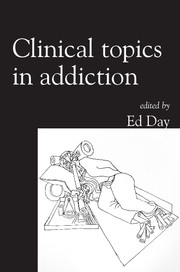Book contents
- Frontmatter
- Contents
- List of tables
- List of boxes
- List of figures
- List of contributors
- Foreword by Nat Wright
- Preface
- 1 What works in drug addiction?
- 2 The development of the drug treatment system in England
- 3 Stimulant use still going strong
- 4 Adverse effects of khat: a review
- 5 What the clinician needs to know about magic mushrooms
- 6 What works in alcohol use disorders?
- 7 Management of alcohol detoxification
- 8 Nicotine addiction and smoking cessation treatments
- 9 Pathological gambling: an overview of assessment and treatment
- 10 Use of investigations in the diagnosis and management of alcohol use disorders
- 11 Laboratory investigations for assessment and management of drug problems
- 12 Pharmacotherapy in dual diagnosis
- 13 Dual diagnosis: management within a psychosocial context
- 14 Treating depression complicated by substance misuse
- 15 Treating anxiety complicated by substance misuse
- 16 An overview of psychological interventions for addictive behaviours
- 17 Motivational interviewing
- 18 Substance misuse in adolescents
- 19 Management of drug misuse in pregnancy
- 20 Intoxication and legal defences
- 21 Substance misuse and violence: the scope and limitations of forensic psychiatry's role
- 22 Literary and biographical perspectives on substance use
- Index
11 - Laboratory investigations for assessment and management of drug problems
Published online by Cambridge University Press: 02 January 2018
- Frontmatter
- Contents
- List of tables
- List of boxes
- List of figures
- List of contributors
- Foreword by Nat Wright
- Preface
- 1 What works in drug addiction?
- 2 The development of the drug treatment system in England
- 3 Stimulant use still going strong
- 4 Adverse effects of khat: a review
- 5 What the clinician needs to know about magic mushrooms
- 6 What works in alcohol use disorders?
- 7 Management of alcohol detoxification
- 8 Nicotine addiction and smoking cessation treatments
- 9 Pathological gambling: an overview of assessment and treatment
- 10 Use of investigations in the diagnosis and management of alcohol use disorders
- 11 Laboratory investigations for assessment and management of drug problems
- 12 Pharmacotherapy in dual diagnosis
- 13 Dual diagnosis: management within a psychosocial context
- 14 Treating depression complicated by substance misuse
- 15 Treating anxiety complicated by substance misuse
- 16 An overview of psychological interventions for addictive behaviours
- 17 Motivational interviewing
- 18 Substance misuse in adolescents
- 19 Management of drug misuse in pregnancy
- 20 Intoxication and legal defences
- 21 Substance misuse and violence: the scope and limitations of forensic psychiatry's role
- 22 Literary and biographical perspectives on substance use
- Index
Summary
Summary Much of the drug testing available today is able to determine the presence or absence of a variety of psychoactive substances in a range of body fluids and tissues. For the results of such tests to be confidently interpreted, additional information is required, including general assessment and history-taking. In a wide range of large psychiatric surveys, substance dependence emerges as one of the most common mental health-related disorders, and it is also the one that is least likely to be treated. The range of available tests can be best considered as acting to support and complement a broader assessment and diagnostic procedure.
The aim of this chapter is to outline the variety of laboratory investigations available that could be considered as biological indicators of substance use and misuse. We will review the strengths and weaknesses of different approaches and different body matrices (urine, blood/plasma monitoring, oral fluid and hair testing), along with other possible materials not usually considered, with a focus on the clinical usefulness of these procedures.
A drug may be detected in any body fluid or tissue, but there are practical limitations to the extent to which samples can be and are used, and the mechanism of collection and supervision of samples are critical to the procedure.
Chain of custody
The procedure of ensuring that an identified sample was provided by a specified individual (chain of custody), and has subsequently been correctly labelled to ensure accuracy, must be properly documented. In the case of urine samples, chain of custody procedures usually require the collection to be witnessed by a designated member of staff (clinician, nurse, drug worker, therapist, etc.) and written confirmation of its validity from the individual voiding the sample, as detailed in Box 11.1 (Wolff et al, 1999a).
Box 11.1 Chain of custody procedures for urine samples
• Before, during and after urination, collection site personnel must keep the urine specimen in sight
• The urine container must be tightly capped, properly sealed and labelled with the patient/client's name and the time and date of collection
• To maintain accountability the approved chain of custody form must be used and it must accompany the sample from initial collection to final disposition
• Reliable transportation (courier system) to the laboratory must be used
- Type
- Chapter
- Information
- Clinical Topics in Addiction , pp. 130 - 148Publisher: Royal College of PsychiatristsPrint publication year: 2007



